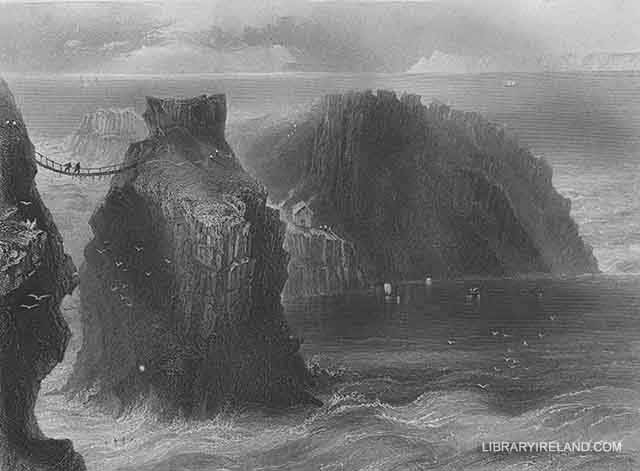Carrick-a-Rede, County Antrim
We were up with the lark on the morning that we left Ballycastle for the Causeway, but our attentive host had anticipated us, and our breakfast was smoking before a brilliant turf-fire. Dawn was just creeping into a sky fortunately clear, as we flourished away, Irish fashion, from the inn-door, and broad daylight found us near the far-famed CARRICK-A-REDE. The new road runs close to this singular chasm, and we had no difficulties to contend with but the mud and water with which the wet season had covered the whole country. The "flying-bridge," as it is called, is removed during the winter; but the scenery of the spot, in other respects, is not susceptible of change, as there is not a tree within sight, and the grass on the summit is as bright in winter as in spring. Carrick-a-Rede signifies the rock in the road, and it so called because it interrupts the salmon in their passage along the coast. The rock is an insulated crag of rudely prismatic basalt, connected with the mainland by a bridge of ropes, thrown across a chasm sixty feet in breadth and eighty-four in depth.
This flying-bridge, which is not unlike the connecting bridge between Holyhead Mountain and the South Stack, is thus formed:—two strong cables, parallel to each other, are fastened to rings inserted in the solid rock on each side of the chasm, and the narrow interval between the ropes is occupied by a boarded pathway. The danger in crossing is attributable to an irregularity in planting the foot upon the board, which, of course, recoils against the impression, and sometimes precipitates the unguarded and courageous venturer into the deep chasm below. Persons accustomed to walk along planks may safely venture over, and the women and boys attached to the fishery carry great loads across with the utmost contempt of danger and apparent ease. It should be remarked that the Island of Carrick-a-Rede is of nearly equal elevation with the mainland—three hundred and fifty feet. In the cliffs near the island is a very beautiful cave, about thirty feet in height, formed entirely of columnar basalt, of which the bases appear to have been removed, so that the unsupported polygonal columns compose the cave.
The chief use of this insulated rock appears to be that of interrupting the salmon, who annually coast along the shore in search of rivers in which to deposit their spawn. Their passage is generally made close to the shore, so that Carrick-a-Rede is very opportunely situated for projecting the interrupting nets. It will be here inquired why the fishermen do not spare themselves the trouble of throwing across this very dangerous bridge, and approach the island by water; but this is perfectly impracticable, owing to the extreme perpendicularity of the basaltic cliffs on every side, except in one small bay, which is not accessible but at particular periods. This fishery, and, indeed, all those along the northern coast, are very productive. The only residents in the little cottage on the island are the clerk and fishermen, and they remain only during the summer months. The fishermen are paid, and all the expenses of fishing defrayed, by proportionate allowances of salmon.

